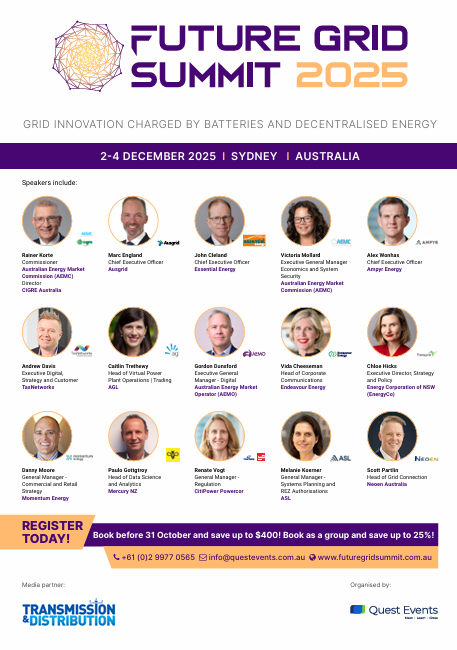Article: Rebuilding the Grid in Real Time

By Mike Cullen
Across Australia, engineers and planners are rebuilding the electricity grid while it is still running. They are racing to connect new renewable generation as coal plants retire, strengthen resilience against extreme weather and embed digital technologies that will change how millions of homes and businesses use energy.
The decisions made now will define how the grid performs long after 2030 is history.
Few leaders see the tension between speed, cost and reliability as clearly as John Cleland, Chief Executive Officer of Essential Energy, which operates one of the Australia’s largest distribution networks. The company’s grid covers 95 per cent of New South Wales and delivers power to 900,000 customers across more than 183,000 kilometres of overhead powerlines. For Cleland, the task is as much about urgency as it is about strategy.
“The single biggest challenge is delivering a new power system at pace while keeping supply safe, reliable and affordable for the people we serve,” he says. “We are evolving the grid in real time, connecting renewable generation as coal exits the system without compromising reliability. In parallel we are increasing the flexibility of distribution networks, facilitating storage, enabling EV charging and microgrids, and using the existing poles and wires to connect new generation projects sooner and with less disruption for regional communities. Through all of this we maintain reliability and power system security. We earn our social licence by doing the basics well, engaging early and openly, and ensuring connected customers get the best of what the transition involves.”
The Race to Deliver
Australia’s regulatory frameworks were built for a centralised and largely stable industry. Cleland argues they must evolve to match the urgency of the transition.
“The regulatory environment now needs to evolve to ensure sufficient new capacity is developed within the required timeframes and emerging technologies can be implemented and optimised for the benefit of customers.”
This call for reform reflects a broader challenge across the sector – balancing the demand for rapid investment with the need to keep bills manageable for households and businesses.
Digitalisation as a Catalyst
While decarbonisation dominates the public conversation, Cleland believes digitalisation is reshaping the sector even faster.
“Digitalisation, the increased use of data and AI, will create the most profound impacts in the energy sector over the next few years, more so than decarbonisation and decentralisation,” he says. “Digitalisation is having, and will continue to have, the greatest impact by allowing our customers and the community generally to gain more control and a better understanding of how they consume, store, trade and export energy.”
Essential Energy’s early decision in 2016 to equip its workforce with iPhones and iPads led to the creation of a field portal and dozens of apps that improved operating efficiency and sparked innovation led by frontline staff.
“AI will turbocharge that innovation, freeing up our staff to do more value-enhancing work and leading to better services for our customers.”
Resilience at the Right Price
Cost pressures remain front of mind for regional and rural communities, yet Cleland says customers want investment in resilience to protect their supply.
“Our staff live and work in regional, rural and remote NSW. We are part of the communities we serve so we understand people are finding it tough financially. As a result our costs, which are passed on to our communities via retailers, remain front of mind with every decision we make. But feedback from our customers showed us that they want us to invest in resilience to protect their energy supply.”
Essential Energy is investing more than 200 million dollars in strengthening the network, including composite poles to better withstand bushfires, stand-alone power systems for high-risk areas and new cybersecurity measures.
“We are not gold-plating the grid. We are investing in practical, economical solutions that will provide long-term benefits. Co-locating generation and load is vital. If they are close to each other, reliability is stronger and overall system costs fall.”
A 2030 Vision for Regional Growth
Cleland imagines a system that is more efficient, decentralised and digitally enabled.
“We see a future where the networks will be far more digitised, serviced by locally generated, cost-effective low-carbon energy. Customers and the network will be more efficient in the way we generate, store, consume or trade electrons– and that will be crucial.”
He links this transformation to economic growth.
“Success will be where electrification has given rise to economic growth and opportunity across regional, rural and remote NSW and all regional Australia. There are huge opportunities for industrial activity to proliferate in regional areas, and into Australia from overseas, as a consequence of wind and solar and our ability to generate, use and store those electrons on an efficient basis.”
Australia’s ability to deliver on this vision will hinge on collaboration between regulators, networks and the communities they serve.
To learn more, meet John and other industry leaders at BESS & DNSP Innovation (Future Grid Summit 2025) this December in Sydney.
Download the Brochure



